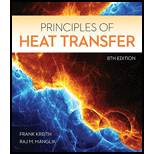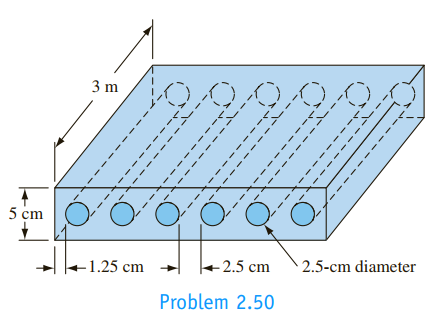
Principles of Heat Transfer (Activate Learning with these NEW titles from Engineering!)
8th Edition
ISBN: 9781305387102
Author: Kreith, Frank; Manglik, Raj M.
Publisher: Cengage Learning
expand_more
expand_more
format_list_bulleted
Concept explainers
Textbook Question
Chapter 2, Problem 2.50P
Compare the rate of heat flow from the bottom to the top of the aluminum structure shown in the sketch below with the rate of heat flow through a solid slab. The top is at v, the bottom at

Expert Solution & Answer
Want to see the full answer?
Check out a sample textbook solution
Students have asked these similar questions
3-55 A multifluid container is connected to a U-tube,
as shown in Fig. P3–55. For the given specific gravities
and fluid column heights, determine the gage pressure at
A. Also determine the height of a mercury column that
would create the same pressure at A. Answers: 0.415 kPa,
0.311 cm
I need help answering parts a and b
Required information
Water initially at 200 kPa and 300°C is contained in a piston-cylinder device fitted with stops. The water is allowed to cool
at constant pressure until it exists as a saturated vapor and the piston rests on the stops. Then the water continues to cool
until the pressure is 100 kPa.
NOTE: This is a multi-part question. Once an answer is submitted, you will be unable to return to this part.
Water
200 kPa
300°C
On the T-V diagram, sketch, with respect to the saturation lines, the process curves passing through the initial, intermediate, and final states of the water. Label the
T, P, and V values for end states on the process curves.
Please upload your response/solution by using the controls provided below.
Chapter 2 Solutions
Principles of Heat Transfer (Activate Learning with these NEW titles from Engineering!)
Ch. 2 - A plane wall, 7.5 cm thick, generates heat...Ch. 2 -
2.2 A small dam, which is idealized by a large...Ch. 2 - 2.3 The shield of a nuclear reactor is idealized...Ch. 2 - A plane wall 15 cm thick has a thermal...Ch. 2 - 2.5 Derive an expression for the temperature...Ch. 2 - A plane wall of thickness 2L has internal heat...Ch. 2 - 2.7 A very thin silicon chip is bonded to a 6-mm...Ch. 2 - 2.9 In a large chemical factory, hot gases at 2273...Ch. 2 - 2.14 Calculate the rate of heat loss per foot and...Ch. 2 - 2.15 Suppose that a pipe carrying a hot fluid with...
Ch. 2 - Prob. 2.16PCh. 2 - Estimate the rate of heat loss per unit length...Ch. 2 - The rate of heat flow per unit length q/L through...Ch. 2 - A 2.5-cm-OD, 2-cm-ID copper pipe carries liquid...Ch. 2 - A cylindrical liquid oxygen (LOX) tank has a...Ch. 2 - Show that the rate of heat conduction per unit...Ch. 2 - Derive an expression for the temperature...Ch. 2 - Heat is generated uniformly in the fuel rod of a...Ch. 2 - 2.29 In a cylindrical fuel rod of a nuclear...Ch. 2 - 2.30 An electrical heater capable of generating...Ch. 2 - A hollow sphere with inner and outer radii of R1...Ch. 2 - 2.34 Show that the temperature distribution in a...Ch. 2 -
2.38 The addition of aluminum fins has been...Ch. 2 - The tip of a soldering iron consists of a 0.6-cm-...Ch. 2 - One end of a 0.3-m-long steel rod is connected to...Ch. 2 - Both ends of a 0.6-cm copper U-shaped rod are...Ch. 2 - 2.42 A circumferential fin of rectangular cross...Ch. 2 - 2.43 A turbine blade 6.3 cm long, with...Ch. 2 - 2.44 To determine the thermal conductivity of a...Ch. 2 - 2.45 Heat is transferred from water to air through...Ch. 2 - 2.46 The wall of a liquid-to-gas heat exchanger...Ch. 2 - Prob. 2.47PCh. 2 - The handle of a ladle used for pouring molten lead...Ch. 2 - 2.50 Compare the rate of heat flow from the bottom...Ch. 2 - 2.51 Determine by means of a flux plot the...Ch. 2 - Prob. 2.52PCh. 2 - Determine the rate of heat transfer per meter...Ch. 2 - Prob. 2.54PCh. 2 - 2.55 A long, 1-cm-diameter electric copper cable...Ch. 2 - Prob. 2.56PCh. 2 - Prob. 2.57PCh. 2 - Prob. 2.58P
Knowledge Booster
Learn more about
Need a deep-dive on the concept behind this application? Look no further. Learn more about this topic, mechanical-engineering and related others by exploring similar questions and additional content below.Similar questions
- A piston-cylinder device contains 0.87 kg of refrigerant-134a at -10°C. The piston that is free to move has a mass of 12 kg and a diameter of 25 cm. The local atmospheric pressure is 88 kPa. Now, heat is transferred to refrigerant-134a until the temperature is 15°C. Use data from the tables. R-134a -10°C Determine the change in the volume of the cylinder of the refrigerant-134a if the specific volume and enthalpy of R-134a at the initial state of 90.4 kPa and -10°C and at the final state of 90.4 kPa and 15°C are as follows: = 0.2418 m³/kg, h₁ = 247.77 kJ/kg 3 v2 = 0.2670 m³/kg, and h₂ = 268.18 kJ/kg The change in the volume of the cylinder is marrow_forwardA piston-cylinder device contains 0.87 kg of refrigerant-134a at -10°C. The piston that is free to move has a mass of 12 kg and a diameter of 25 cm. The local atmospheric pressure is 88 kPa. Now, heat is transferred to refrigerant-134a until the temperature is 15°C. Use data from the tables. R-134a -10°C Determine the final pressure of the refrigerant-134a. The final pressure is kPa.arrow_forwardThe hydraulic cylinder BC exerts on member AB a force P directed along line BC. The force P must have a 560-N component perpendicular to member AB. A M 45° 30° C Determine the force component along line AB. The force component along line AB is N.arrow_forward
- ! Required information A telephone cable is clamped at A to the pole AB. The tension in the left-hand portion of the cable is given to be T₁ = 815 lb. A 15° 25° B T₂ Using trigonometry, determine the required tension T₂ in the right-hand portion if the resultant R of the forces exerted by the cable at A is to be vertical. The required tension is lb.arrow_forwardWhat are examples of at least three (3) applications of tolerance fitting analysis.arrow_forwardThe primary material used in the production of glass products is silica sand. True or Falsearrow_forward
- Which one of the following is the most common polymer type in fiber-reinforced polymer composites? thermosets thermoplastics elastomers none of the abovearrow_forwardA pattern for a product is larger than the actual finished part. True or Falsearrow_forwardIn the lost foam process, the pattern doesn’t need to be removed from the mold. True or Falsearrow_forward
- Tempering eliminates internal stresses in glass. True or Falsearrow_forwardThermoset polymers can be recycled with little to no degradation in properties. True or Falsearrow_forwardTwo forces are applied as shown to a hook support. The magnitude of P is 38 N. 50 N 25° DG a 터 Using trigonometry, determine the required angle a such that the resultant R of the two forces applied to the support will be horizontal. The value of a isarrow_forward
arrow_back_ios
SEE MORE QUESTIONS
arrow_forward_ios
Recommended textbooks for you
 Principles of Heat Transfer (Activate Learning wi...Mechanical EngineeringISBN:9781305387102Author:Kreith, Frank; Manglik, Raj M.Publisher:Cengage Learning
Principles of Heat Transfer (Activate Learning wi...Mechanical EngineeringISBN:9781305387102Author:Kreith, Frank; Manglik, Raj M.Publisher:Cengage Learning

Principles of Heat Transfer (Activate Learning wi...
Mechanical Engineering
ISBN:9781305387102
Author:Kreith, Frank; Manglik, Raj M.
Publisher:Cengage Learning
Understanding Conduction and the Heat Equation; Author: The Efficient Engineer;https://www.youtube.com/watch?v=6jQsLAqrZGQ;License: Standard youtube license